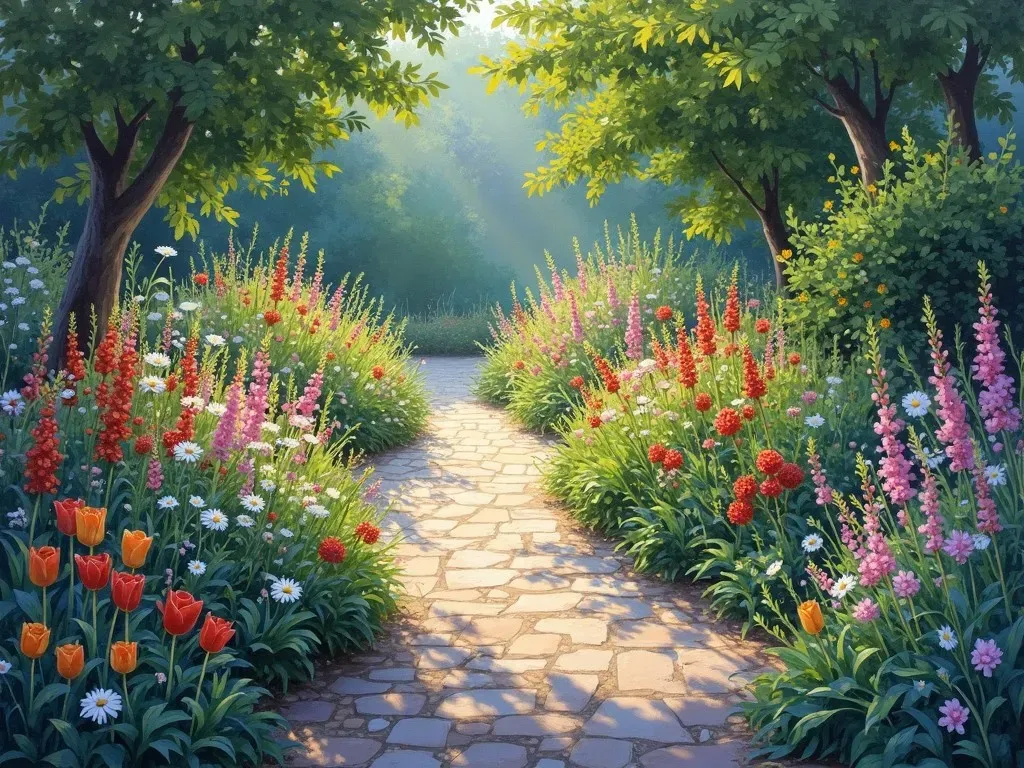claude monet’s garden paintings, particularly those from his enchanting garden at Giverny, embody the pinnacle of Impressionist artistry. His works illustrate a passion for nature and an innovative approach to color and light, making Monet one of the most celebrated artists of his time.
Monet’s garden paintings capture diverse floral arrangements, tranquil water features, and vibrant nature scenes. Each piece offers a glimpse into his artistic process and the serene beauty he cultivated in Giverny.
The Artistic Garden at Giverny
Monet designed his garden at Giverny not just as a personal retreat but as a living canvas filled with plants that inspired many of his most famous works. The carefully arranged flower beds and the iconic Japanese bridge over the water lily pond became frequent subjects in his paintings.
In 1893, Monet constructed a water lily pond, where he envisioned creating a space "for the pleasure of the eye." This vision materialized into a series of paintings that depicted the serenity and beauty of his water garden.
Key Works of Monet Garden Paintings
Here are some of his most iconic works that reflect his love for gardens:
| Title | Year | Description | Location |
|---|---|---|---|
| The Artist’s Garden at Giverny | 1900 | A vivid depiction of his blossoming garden filled with various flowers. | Musée d’Orsay, Paris |
| Japanese Footbridge | 1899 | Features the serene wooden footbridge connecting different parts of the garden. | National Gallery of Art |
| Water Lilies | 1914-1926 | A monumental series that captures the changing lights and reflections on the pond. | Museum of Modern Art (MoMA) |
Monet’s Use of Color and Light
Monet’s approach to color and light in his garden paintings is groundbreaking. He often painted the same scene multiple times to capture the changes in light and atmosphere throughout the day and seasons.
Painting Techniques
- Color Palette: Monet employed a vibrant color palette, often layering paints to enhance depth.
- Brushwork: His signature loose brushwork created dynamic textures, bringing the garden to life.
- Perspective: He masterfully used perspective to draw viewers into the lushness of his landscapes.
Historical Context
The Impressionist movement emerged in the late 19th century, characterized by a focus on capturing fleeting moments and the effects of light. Monet, along with other contemporaries like Renoir and Degas, challenged traditional painting Techniques and chose to paint en plein air, or outdoors, to seize the natural beauty around him.
| Fact | Description |
|---|---|
| Birth Year | Claude Monet was born on November 14, 1840. |
| Major Influences | Influenced by Japanese prints and nature. |
| Final Years | He dedicated his last years to water lily paintings. |
| Number of Water Lily Works | Created over 250 paintings of water lilies. |
The Beauty of Monet’s Themes
Monet’s garden paintings explore themes of tranquility, the passage of time, and the intimate relationships between humans and nature:
Tranquility
The serenity depicted in Monet’s works invites the viewer to enter a peaceful realm away from the chaos of everyday life.
The Passage of Time
Monet effectively showcased the changing seasons, demonstrating how the garden transforms over time — each season introducing its unique colors and vibes.
Nature’s Intimacy
He fostered a close connection with nature, emphasizing how vital it was in both his life and work. The garden became more than just a backdrop; it was an integral character in his life’s narrative.
Exhibition and Legacy
Monet’s garden works are exhibited in numerous renowned art institutions globally. His legacy persists through his contributions to the Impressionist movement, influencing countless artists and art lovers.
Art Institutions Displaying Monet’s Work:
| Institution | Country | Noteworthy Monet Works |
|---|---|---|
| Musée d’Orsay | France | The Artist’s Garden at Giverny |
| National Gallery of Art | USA | The Japanese Footbridge |
| Museum of Modern Art (MoMA) | USA | Water Lilies |
| Bridge over a Pond of Water Lilies | USA | A series capturing the garden at different times |
FAQ About Monet Garden Paintings
Q: What inspired Monet to create his garden at Giverny?
A: Monet aimed to create an ideal landscape that would inspire his art and wanted a space where he could cultivate beauty and tranquility.
Q: How many paintings did Monet create in his garden?
A: Monet created over 250 paintings that reflect various aspects and views of his garden, with water lilies and the Japanese bridge being some of the most iconic.
Q: What is the significance of light in Monet’s garden paintings?
A: Light plays a crucial role in his paintings, as Monet captured how it constantly changes the appearance of colors and shapes throughout the day, generating depth and emotion in his work.
Q: Can I visit Monet’s Garden at Giverny?
A: Yes, Monet’s garden is now a public museum, allowing visitors to explore the beautiful landscape he created. For more details, please check the official website of Musée Giverny.
Monet garden paintings are not merely art; they are an experience—a breathtaking testament to the power of nature and the beauty that can be captured on canvas. Each brushstroke reveals a passion for color, light, and the changing seasons, inviting viewers into a world where art and nature coexist harmoniously.
